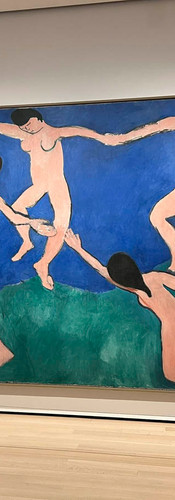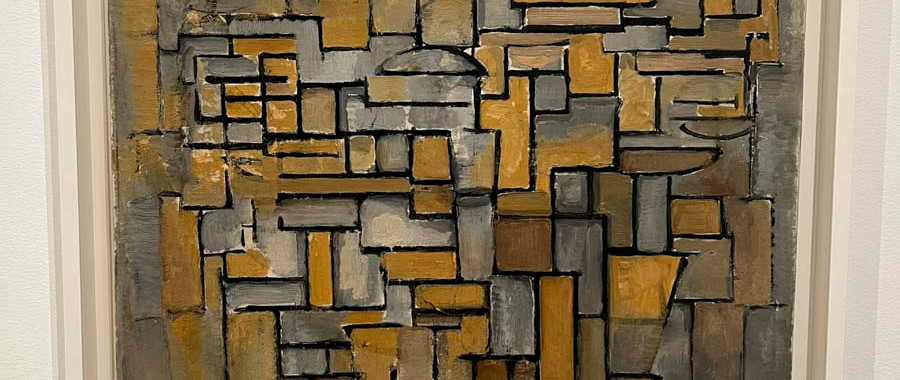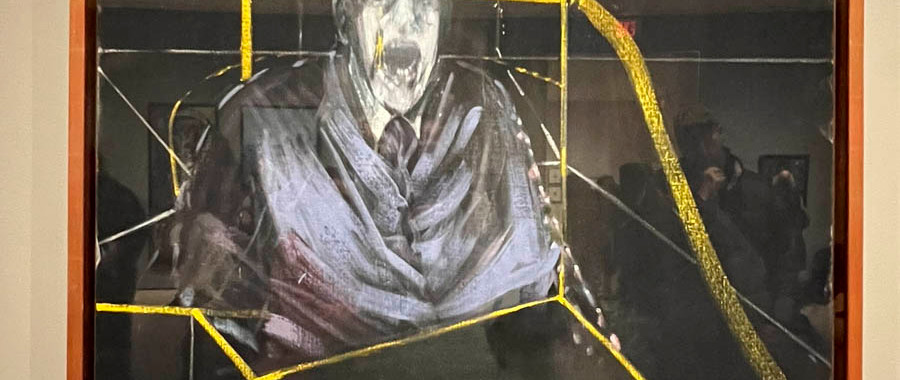The MoMA in Manhattan, New York: Temple of Modern Art between Avant-garde and Contradiction
- The Introvert Traveler
- Apr 17
- 8 min read

Last visit : January 2025
My rating : 8/10
Visit duration : 6/8 hours
Web : https://www.moma.org
Origins and Mission: The American Modernist Utopia
MoMA was founded in 1929 by three far-sighted women: Lillie P. Bliss, Mary Quinn Sullivan, and Abby Aldrich Rockefeller. The date is not accidental: it was inaugurated just nine days after the Wall Street crash, a powerful signal of faith in creative intelligence as the foundation of rebirth. Its foundation occurred at a time when modernism began to take on the characteristics of a global revolution, positioning itself as an ethical and aesthetic alternative to the nineteenth-century academic tradition.
The mission of MoMA – as stated in its charter – was to "help people understand and enjoy the visual arts of our time". A manifesto of modernity, therefore, that has evolved over time while maintaining a consistent common thread: the incessant tension between experimentation and institutionalization.
The Role of MoMA in the Global Art System
MoMA engages in a dialogue – sometimes tension – with other central institutions of contemporary art, such as the Tate Modern, the Centre Pompidou, or the MAXXI. If the Pompidou favors the hybridization of cultures and media, and the Tate focuses on a post-colonial narrative, MoMA tends to maintain a still strongly Eurocentric and North American posture, even if in recent years it has begun a process of “curatorial decolonization”, broadening the representation of African, Latin American, and South-East Asian artists.
His temporary exhibitions are often epochal events – think of the retrospective on Gerhard Richter or that on Adrian Piper – and contribute to defining the very canon of contemporary art.
The best museum in New York
Visiting the Museum of Modern Art in New York is like crossing the threshold of a shrine of twentieth-century imagination. The MoMA, in the beating heart of Manhattan, is not just a museum space: it is a cultural palimpsest that preserves, exhibits, questions and sometimes distorts the very concept of art. Each of its corridors is a symphony of intentions, each room a node in the artistic constellation that defined the last century and continues to orient the current one.
For art lovers visiting New York, MOMA is a must-see, along with the Metropolitan Museum, the Frick Collection, the Guggenheim Museum, the Morgan Library, and the Neue Galerie .

Unlike what I wrote about the MET and especially the Guggenheim, which I found in some respects below expectations, the MOMA is, in its sector, a formidable museum; while at the MET (with which the comparison is inevitable since it is the other large art museum in New York) I had the perception of a collection assembled in a historical phase in which the main works of ancient art had already been grabbed by the oldest European museums, forcing the MET to make up for the lack of works of absolute importance with the quantity of works (obviously in relative terms), the MOMA is evidently a museum established with the availability of large amounts of capital (does the name Rockefeller mean anything?) precisely in the period in which the artistic avant-gardes of the 20th century were asserting themselves and probably the European museums did not have the same financial potential; as far as the great authors of the period from the end of the 19th century to the middle of the 20th century are concerned, the MOMA is a museum that has few competitors capable of competing with the richness of the collection and the quantity of outstanding works. From Van Gogh to Cézanne, from Matisse to Picabia, from Picasso to Braque, from Modigliani to Brancusi, from Mondrian to Klimt, passing through Gauguin, Seurat, Mirò, Dix, De Chirico, Dalì, Monet, Magritte, some of the most important works of this period are here.
To the quality of the collection that can only excite any lover of modern art, the MOMA combines a glamorous context like few other museums in the world; there is nothing cooler than walking through the halls between 5th and 6th avenue while outside the windows the skyscrapers of Manhattan stand out and, as the hours pass, the light redefines their shapes and volumes.


But it also has some flaws...
First of all, in addition to being, at least in my opinion, the best museum in New York, it is also the most popular, in all senses of the term; here more than anywhere else you feel and suffer the presence of hordes of boorish tourists who flood the rooms and crowd the most famous paintings to take useless selfies. Furthermore, again in my opinion, the arrangement of the works could be better; of the six floors of the building only two (the fifth and the fourth) are dedicated to the most popular works, namely the works of modern art, while the rest of the space is dedicated to works of contemporary art that are not as exciting (you know, those questionable forms of expression that through inscrutable intellectual or ideological short circuits or manifestations of radical humor, lead to exhibiting bales of hay pierced by plastic flamingos and things like that); this obviously leads almost all of the public to flow into less than half of the building, creating phenomena of real congestion in a few selected rooms; if some of the photos I managed to take seem a bit rough, considering the acrobatic conditions in which they were taken; probably visiting the museum during the Christmas holidays didn't help. It must be said that the MOMA, in addition to being a world-famous museum, is also a cultural institution that aspires to be a supporter of innovation, so it is reasonable that the spaces are divided between great works of the past and areas intended for the present and the future... if then the works on display are not necessarily up to the level of the places, it is not necessarily the museum's responsibility but also a bit of a rush on the part of contemporary artists to produce art that is not just provocation for its own sake.
The museum itinerary: from painting to performance
Milestones of the permanent collection
The permanent collection of MoMA is one of the most impressive and influential bodies of modern and contemporary art. Some masterpieces constitute its “icons” – a term to be used with caution but unavoidable in some cases.
Les Demoiselles d'Avignon (1907) by Pablo Picasso : a founding work of Cubism and perhaps of modern art tout court, it breaks the grammar of the classical nude and inaugurates a new perspective on form and space.
The Starry Night (1889) by Vincent van Gogh : painted in the psychiatric hospital of Saint-Rémy, this canvas embodies the confluence of inner vision and psychic reality, and should also be read in light of the artist's letters to Theo.
The Persistence of Memory (1931) by Salvador Dalí : probably the most famous work of the entire surrealist movement. Melting clocks, distorted time and dreamlike landscapes. It was purchased by MOMA from a New York gallery in 1934 for $350 (equivalent to $7,500 today).
Dance (1909) by Henri Matisse : first version of the work also exhibited at the Hermitage in St. Petersburg. A whirlwind of joy expressed in three colors.
Number 31 (1950) by Jackson Pollock : an example of dripping, which is not only a technique but an epiphany: the canvas is the battlefield, and the pictorial action becomes an existential document.
Hidden Gems at Manhattan's MOMA
Among all the well-known and very well-known works exhibited at the MOMA, I would like to point out a small group of works that could go unnoticed; it is a group of xylographs by Paul Gauguin that I found to be of extraordinary graphic quality as well as more effective and sincere in paying homage to and reinterpreting tribal art than the more famous Polynesian paintings by the French artist; maybe it's because I love xylographs as an art form, maybe it's because Gauguin, as a painter, is not at the top of my preferences, but these little jewels, exhibited near Van Gogh's very famous Starry Night, risk going unnoticed.
MOMA is not the first museum that lovers of Gustav Klimt's art would flock to (other places like the Belvedere in Vienna or the Neue Galerie in New York would be at the top of the list), but MOMA does boast a small and by no means negligible collection of the Viennese art giant, which I believe deserves a special mention, if only for my passion for this artist, but also for the not inconsiderable quality of the works that MOMA has managed to acquire.

"Ceci n'est pas l'architecture, se sont le styles". Another "work" that could go unnoticed among so many famous masterpieces of modern art is this manuscript by Le Corbusier. According to the illustrated card, it is a drawing made by the architect during a lesson in Buenos Aires in 1929. It is inevitable to think of Magritte's "ceci n'est pas un pipe" and the demystification of art professed by Marcel Duchamp, two authors exhibited at the MOMA, but also, still speaking of Duchamp, of the concert of ready-made art expressed in this artifact, which I presume was quickly sketched by the famous architect while he was entertaining the audience and preserved by some collaborator to become itself a work of art exhibited in the museum. It is a work that stimulates a series of almost hypertextual references and amuses for the paradoxes it expresses.
Design, photography, architecture and media
Unlike many European museums – still often rigidly organized by medium – MoMA has embraced an encyclopedic vision of the modern since its inception. The architecture and design department is among the oldest in the world (founded in 1932), with historic pieces such as Gerrit Rietveld’s Red Blue Chair and Le Corbusier’s chaise longue .
No less important is the photography sector, with masters such as Diane Arbus , Walker Evans, Cindy Sherman and Nan Goldin. The intertwining of image and identity, between document and construction of the self, emerges as a key theme.
The services
As almost always happens in New York, if a place wants to give itself a slightly snobbish and upper-middle-class tone... the cuisine is Italian. If you are Italian you might feel a bit taken for a ride to see yourself served for 25 dollars a dish that you could eat at home for 10 euros, after having spent 1,000 dollars on a plane, but visiting New York also means acquiring the ecumenical awareness that a local cuisine does not exist and much of the best food in New York is either Italian or Chinese or Japanese, or from other ethnic-culinary minorities. That said, the MOMA restaurant is shamelessly expensive, but it gives what it gets: the white pizza with rocket, prosciutto crudo and ricotta salata was probably the best museum meal of my life.
Before leaving the museum, spend some time in the library: it is extraordinarily well-stocked and I reluctantly had to leave there many books that I could have happily dragged around and loaded into my luggage to weigh it down beyond the permitted limit.
Conclusion: MoMA between exhibition and provocation
MoMA is not just a museum: it is an epistemological machine, a lens through which to observe the twentieth century as an era of fractures and utopias, of ruptures and recompositions. It is also, inevitably, a place of power, an expression of the New York cultural elite that canonizes, selects, excludes. But precisely for this reason it must be visited with a critical spirit, with the awareness that each work contained therein is an act of narration that starts from the end of the nineteenth century and reaches the current ideologies that are also expressed through contemporary art. At a first, more superficial level of reading, it is an exceptional place of exhibition of the best art produced over the course of the last century, going into more detail it is a cultural institution that, in addition to exhibiting art, contributes to the continuous evolution of Western and global cultural identity and in any case will not leave the most attentive visitor indifferent who cannot help but leave MOMA visually satisfied, but also intellectually stimulated.




































































































Comments